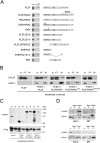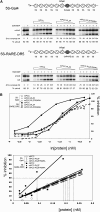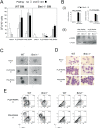The PRC1 Polycomb group complex interacts with PLZF/RARA to mediate leukemic transformation
- PMID: 19451220
- PMCID: PMC2685534
- DOI: 10.1101/gad.512009
The PRC1 Polycomb group complex interacts with PLZF/RARA to mediate leukemic transformation
Abstract
Ectopic repression of retinoic acid (RA) receptor target genes by PML/RARA and PLZF/RARA fusion proteins through aberrant recruitment of nuclear corepressor complexes drives cellular transformation and acute promyelocytic leukemia (APL) development. In the case of PML/RARA, this repression can be reversed through treatment with all-trans RA (ATRA), leading to leukemic remission. However, PLZF/RARA ectopic repression is insensitive to ATRA, resulting in persistence of the leukemic diseased state after treatment, a phenomenon that is still poorly understood. Here we show that, like PML/RARA, PLZF/RARA expression leads to recruitment of the Polycomb-repressive complex 2 (PRC2) Polycomb group (PcG) complex to RA response elements. However, unlike PML/RARA, PLZF/RARA directly interacts with the PcG protein Bmi-1 and forms a stable component of the PRC1 PcG complex, resulting in PLZF/RARA-dependent ectopic recruitment of PRC1 to RA response elements. Upon treatment with ATRA, ectopic recruitment of PRC2 by either PML/RARA or PLZF/RARA is lost, whereas PRC1 recruited by PLZF/RARA remains, resulting in persistent RA-insensitive gene repression. We further show that Bmi-1 is essential for the PLZF/RARA cellular transformation property and implicates a central role for PRC1 in PLZF/RARA-mediated myeloid leukemic development.
Figures






References
-
- Barna M, Merghoub T, Costoya JA, Ruggero D, Branford M, Bergia A, Samori B, Pandolfi PP. Plzf mediates transcriptional repression of HoxD gene expression through chromatin remodeling. Dev Cell. 2002;3:499–510. - PubMed
-
- Batsche E, Yaniv M, Muchardt C. The human SWI/SNF subunit Brm is a regulator of alternative splicing. Nat Struct Mol Biol. 2006;13:22–29. - PubMed
-
- Bel S, Coré N, Djabali M, Kieboom K, Van der Lugt N, Alkema MJ, Van Lohuizen M. Genetic interactions and dosage effects of Polycomb group genes in mice. Development. 1998;125:3543–3551. - PubMed
-
- Di Croce L, Raker VA, Corsaro M, Fazi F, Fanelli M, Faretta M, Fuks F, Lo Coco F, Kouzarides T, Nervi C, et al. Methyltransferase recruitment and DNA hypermethylation of target promoters by an oncogenic transcription factor. Science. 2002;295:1079–1082. - PubMed
Publication types
MeSH terms
Substances
LinkOut - more resources
Full Text Sources
Other Literature Sources
Medical
